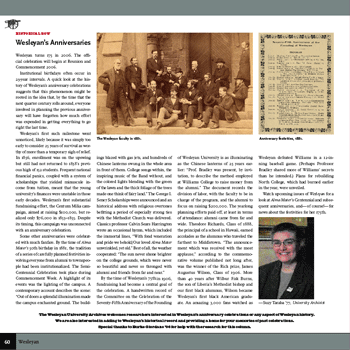HISTORICAL ROW: WESLEYAN’S ANNIVERSARIES
 Wesleyan turns 175 in 2006. The official celebration will begin at Reunion and Commencement 2006.
Wesleyan turns 175 in 2006. The official celebration will begin at Reunion and Commencement 2006.
Institutional birthdays often occur in 25-year intervals. A quick look at the history of Wesleyan’s anniversary celebrations suggests that this phenomenon might be rooted in the idea that, by the time that the next quarter century rolls around, everyone involved in planning the previous anniversary will have forgotten how much effort was expended in getting everything to go right the last time.
Wesleyan’s first such milestone went unnoticed, likely because it was simply too early to consider 25 years of survival as worthy of more than a temporary sigh of relief. In 1856, enrollment was on the upswing but still had not returned to 1838’s previous high of 152 students. Frequent national financial panics, coupled with a system of scholarships that yielded minuscule income from tuition, meant that the young university’s finances were unstable in those early decades. Wesleyan’s first substantial fundraising effort, the Centum Milia campaign, aimed at raising $100,000, but realized only $76,000 in 1853-1855. Despite its timing, this campaign was unconnected with an anniversary celebration.
Some other anniversaries were celebrated with much fanfare. By the time of Alma Mater’s 50th birthday in 1881, the tradition of a series of carefully planned festivities involving everyone from alumni to townspeople had been institutionalized. The Semi-Centennial Celebration took place during Commencement Week. A highlight of its events was the lighting of the campus. A contemporary account describes the scene: “Out of doors a splendid illumination made the campus enchanted ground. The buildings blazed with gas jets, and hundreds of Chinese lanterns swung in the whole area in front of them. College songs within, the inspiring music of the Band without, and the colored lights blending with the green of the lawn and the thick foliage of the trees made one think of fairy land.” The George I. Seney Scholarships were announced and an historical address with religious overtones befitting a period of especially strong ties with the Methodist Church was delivered. Classics professor Calvin Sears Harrington wrote an occasional hymn, which included the immortal lines, “With fond veneration and pride we behold/Our loved Alma Mater unwrinkled, yet old.” Best of all, the weather cooperated: “The sun never shone brighter on the college grounds, which were never so beautiful and never so thronged with alumni and friends from far and near.”
By the time of Wesleyan’s 75th in 1906, fundraising had become a central goal of the celebration. A handwritten record of the Committee on the Celebration of the Seventy-Fifth Anniversary of the Founding of Wesleyan University is as illuminating as the Chinese lanterns of 25 years earlier: “Prof. Bradley was present, by invitation, to describe the method employed at Williams College to raise money from the alumni.” The document records the division of labor, with the faculty to be in charge of the program, and the alumni to focus on raising $200,000. The yearlong planning efforts paid off, at least in terms of attendance: alumni came from far and wide. Theodore Richards, Class of 1888, the principal of a school in Hawaii, earned accolades as the alumnus who traveled the farthest to Middletown. “The announcement which was received with the most applause,” according to the commemorative volume published not long after, was the winner of the Rich prize, James Augustus Wilson, Class of 1906. More than 40 years after Wilbur Fisk Burns, the son of Liberia’s Methodist bishop and our first black alumnus, Wilson became Wesleyan’s first black American graduate. An amazing 3,000 fans watched as Wesleyan defeated Williams in a 12-inning baseball game. (Perhaps Professor Bradley shared more of Williams’ secrets than he intended.) Plans for rebuilding North College, which had burned earlier in the year, were unveiled.
Watch upcoming issues of Wesleyan for a look at Alma Mater’s Centennial and subsequent anniversaries, and–of course!–for news about the festivities for her 175th.
–Suzy Taraba ’77, University Archivist
